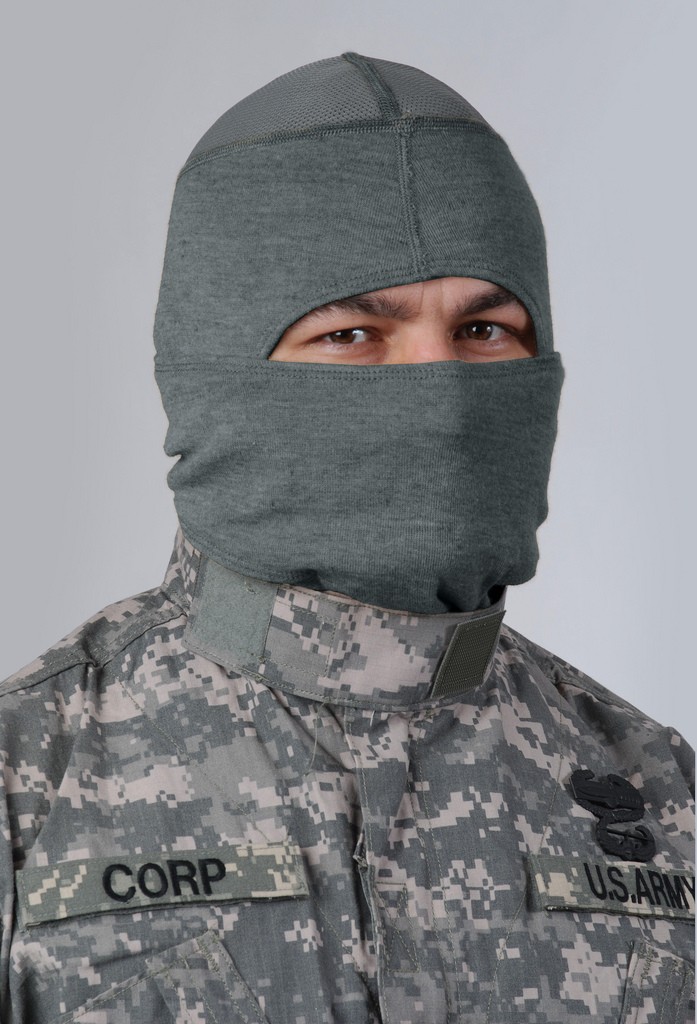
FT. BELVOIR, Va. (March 12, 2010) -- For an item weighing only three ounces, the Army's Light Weight Performance Hood (LPH) is a key piece of gear. It can save Soldiers from severe, disfiguring, even life-threatening burns to the face, ears, and neck.
The LPH was designed for all Soldiers in a configuration that would be acceptable to Soldiers. When worn with a fire-resistant uniform, the hood greatly reduces the threat of a burn injury.
The LPH, which replaces the Anti-Flash Hood in order to reduce bulk and heat retention, has proven its usefulness in combat operations since it was first fielded in 2009, at a rate of two for each deploying Soldier. "The hood is made of a fire-resistant, no-melt, no-drip material for the Soldier's head and face that provides protection from flash flames and thermal threats," explained CSM Bernard McPherson, Command Sergeant Major at Program Executive Office (PEO) Soldier.
PEO Soldier, based at Fort Belvoir, VA, is the Army acquisition agency responsible for developing, procuring, and fielding nearly everything Soldiers wear or carry. Mr. Jeff Myhre is the Assistant Product Manager responsible for this product as well as many other fire-resistant (FR) products developed and fielded by PEO Soldier.
Myhre and his team of engineers continuously seek improvements to protect Soldiers. "We are always on the lookout for new fabrics and technologies to prevent Soldiers from having to suffer second- and third-degree burns," Myrhe said. "We want Soldiers to have FR protection wherever and whenever they need it."
Facial burns are particularly dangerous. "The face is very difficult to protect from the constant risk of exposure to flash flame in combat, and facial burns are often devastating," said LTC (P) Evan Renz, Director of the U.S. Army Institute of Surgical Research Burn Center at Brooke Army Medical Center in San Antonio, Texas. "We continue to observe the benefits of improved FR materials and clothing, and wearing a hood could offer vital protection when and where Soldiers really need it."
The one-size-fits-all LPH is comfortable as well as functional, said SFC William Corp, Equipment Modernization NCO for PEO Soldier's Product Manager Soldier Clothing and Individual Equipment (PM SCIE). "With today's fabric technology, it's lightweight and breathable," SFC Corp explained.
"We understand that Soldiers are less likely to wear the hood if it is hot or irritating," said LTC Michael Sloane, PM SCIE. "The LPH has a ventilated mesh dome to minimize heat stress in hot or dry climates, while providing limited heat retention in cool climates. It is moisture-wicking, anti-microbial and anti-odor," LTC Sloane added.
The LPH is Foliage Green and blends very well in most environments. It is further concealed by the Soldier's helmet, Myhre noted. With the Army's decision to provide FR uniforms in MultiCam to Soldiers in Afghanistan, PM SCIE "will be evaluating a color adjustment in the near future" for the LPH to ensure a good match with MultiCam.
Just one more piece of gear to carry, a Soldier might say of the LPH. But the hood fits easily in a MOLLE grenade pouch or uniform pocket and is well worth its weight on the battlefield.
"Without a doubt, it's worth wearing," SFC Corp said. "Burns are nasty business. Even minor burns can keep me or my Soldiers out of the fight."
For more information and a video on the Light Weight Performance Hood, visit <a href="http://peosoldier.armylive.dodlive.mil/">the PEO Soldier blog site</a>.

Social Sharing